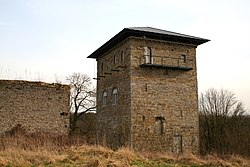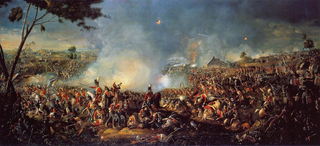
The Battle of Waterloo was fought on Sunday, 18 June 1815, near Waterloo in Belgium, part of the United Kingdom of the Netherlands at the time. A French army under the command of Napoleon Bonaparte was defeated by two of the armies of the Seventh Coalition, a British-led coalition consisting of units from the United Kingdom, the Netherlands, Hanover, Brunswick, and Nassau, under the command of the Duke of Wellington, referred to by many authors as the Anglo-allied army or Wellington's army, and a Prussian army under the command of Field Marshal von Blücher, referred to also as Blücher's army. The battle marked the end of the Napoleonic Wars. The battle was contemporaneously known as the Battle of Mont Saint-Jean or La Belle Alliance.

The Battle of Ligny was fought on 16 June 1815, in which French troops of the Armée du Nord under the command of Napoleon I defeated part of a Prussian army under Field Marshal Blücher, near Ligny in present-day Belgium. The battle resulted in a tactical victory for the French, but the bulk of the Prussian army survived the battle in good order and played a role two days later at the Battle of Waterloo, having been reinforced by Prussian troops who had not participated at Ligny. The battle of Ligny was the last victory in Napoleon's military career.

The Hundred Days War, also known as the War of the Seventh Coalition, marked the period between Napoleon's return from eleven months of exile on the island of Elba to Paris on 20 March 1815 and the second restoration of King Louis XVIII on 8 July 1815. This period saw the War of the Seventh Coalition, and includes the Waterloo Campaign, the Neapolitan War as well as several other minor campaigns. The phrase les Cent Jours was first used by the prefect of Paris, Gaspard, comte de Chabrol, in his speech welcoming the king back to Paris on 8 July.

The Battle of Quatre Bras was fought on 16 June 1815, as a preliminary engagement to the decisive Battle of Waterloo that occurred two days later. The battle took place near the strategic crossroads of Quatre Bras and was contested between elements of the Duke of Wellington's Anglo-allied army and the left wing of Napoleon Bonaparte's French Armée du Nord under Marshal Michel Ney. While the battle was a coalition victory, Napoleon achieved his larger strategic aim of preventing Wellington's forces from aiding the Prussian army at the Battle of Ligny, which the French won the same day.

The Battle of Wavre was the final major military action of the Hundred Days campaign and the Napoleonic Wars. It was fought on 18–19 June 1815 between the Prussian rearguard, consisting of the Prussian III Corps under the command of General Johann von Thielmann and three corps of the French army under the command of Marshal Grouchy. A blocking action, this battle kept 33,000 French soldiers from reaching the Battle of Waterloo and so helped in the defeat of Napoleon at Waterloo.

The Waterloo campaign was fought between the French Army of the North and two Seventh Coalition armies, an Anglo-allied army and a Prussian army. Initially the French army was commanded by Napoleon Bonaparte, but he left for Paris after the French defeat at the Battle of Waterloo. Command then rested on Marshals Soult and Grouchy, who were in turn replaced by Marshal Davout, who took command at the request of the French Provisional Government. The Anglo-allied army was commanded by the Duke of Wellington and the Prussian army by Prince Blücher.

This is the complete order of battle for the four major battles of the Waterloo campaign.

Bothey is a village of Wallonia and a district of the municipality of Gembloux, located in the province of Namur, Belgian.
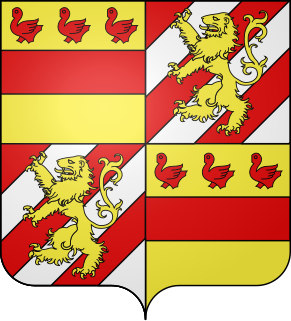
Saint-Amand is a village of Wallonia and a district of the municipality of Fleurus, located in the Arrondissement of Charleroi,province of Hainaut, Belgium.
Colonel Ernst Ludwig Wilhelm von Bismarck was a Prussian officer during the Napoleonic Wars.

The Waterloo campaign commenced with a pre-emptive attack by the French Army of the North under the command of Napoleon Bonaparte. The first elements of the Army of the North moved from their peacetime depots on 8 June to their rendezvous point just on the French side of the Franco-Belgian border. They launched a pre-emptive attack on the two Coalition armies that were cantoned in Belgium—the Anglo-allied army under the command of the Duke of Wellington, and a Prussian army under the command of Prince Blücher.

After the fighting at Quatre Bras the two opposing commanders Marshal Ney and the Duke of Wellington initially held their ground while they obtained information about what had happened at the larger Battle of Ligny. They received intelligence that the Prussian army under the command of Prince Blücher had been defeated by the French Army of the North under the command of Napoleon Bonaparte.

On 16 June 1815, the French defeated the Prussians at the Battle of Ligny. The Prussians successfully disengaged and withdrew north to Wavre where they regrouped, and later advanced westward with three corps to attack the right flank of the French army at the Battle of Waterloo. The French were slow to exploit Ligny; Napoleon wasted the morning of 17 June with a late breakfast and touring the previous day's battlefield before organising a pursuit of the two Coalition armies. Napoleon and Marshal Michel Ney took the French reserves to pursue the Duke of Wellington's Anglo-allied army. Marshal Emmanuel de Grouchy was ordered to pursue and harry the Prussians and prevent them from regrouping.
The Trois Burettes Inn was situated at the crossroads of Namur high road and the Old Roman Road, in Belgium. It was a notable location in two battles:
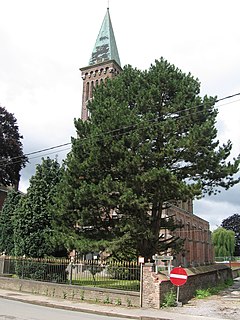
Wagnelée is a village of Wallonia and a district of the municipality of Fleurus, located in the Arrondissement of Charleroi, province of Hainaut, Belgium.

Brye is a village of Wallonia that is part of the municipality of Fleurus, Belgium, in the Arrondissement of Charleroi in the province of Hainaut. Its post code is 6222, and telephone zone code is 071.

Tongrinne is a village of Wallonia and a district of the municipality of Sombreffe, located in the province of Namur, Belgium.

Boignée is a village of Wallonia and a district of the municipality of Sombreffe, located in the province of Namur, Belgium.

Tongrenelle is a hamlet in the municipality of Sombreffe, Wallonia Region, Belgium. It is east of the village of Ligny and north of the village of Boignée and on the south-eastern side of the village of Tongrinne.
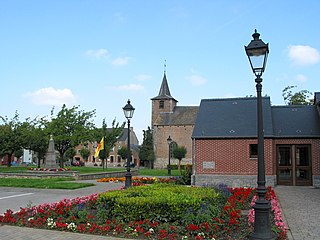
Balâtre is a village of Wallonia and a district of the municipality of Jemeppe-sur-Sambre, located in the province of Namur, Belgium.
